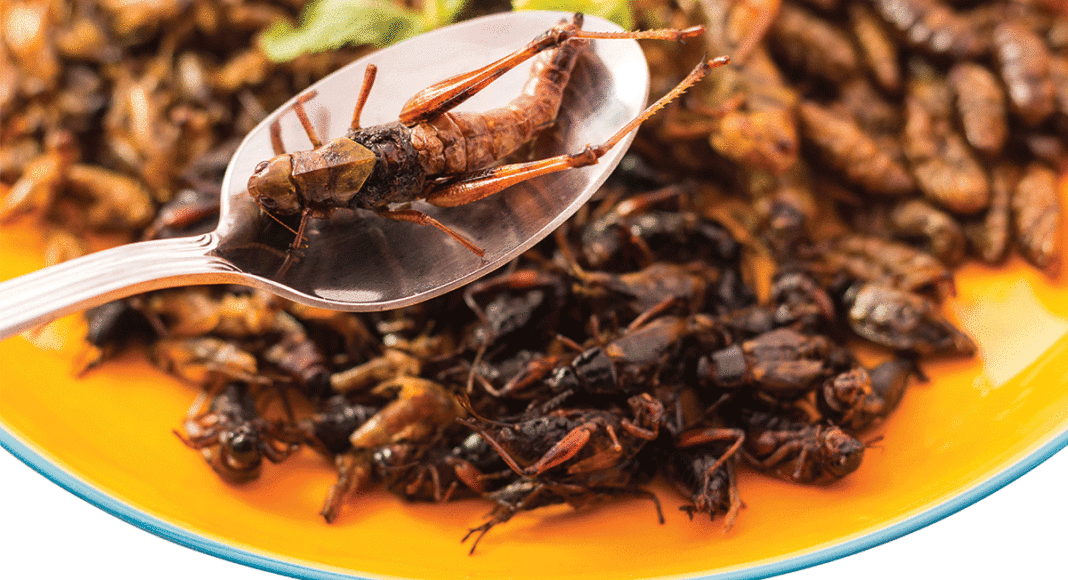The Food & Agriculture Organization (FAO) of the United Nations estimates that by the year 2050, 9 billion people will call the Earth home—and that current food production will need to almost double in order to meet the nutritional needs of the population. The FAO estimates that around 1 billion people worldwide are currently chronically hungry. When you add in challenges like water shortages, climate change, overfished oceans, dwindling land availability, and increased meat production costs, the prospect of feeding future generations seems increasingly dire.
It’s time to get innovative, and one possible solution could be … insects? In 2013, the FAO released a report advocating for their consumption by humans. “Above all, it is our hope that this publication will raise awareness of the many valuable roles that insects play in sustaining nature and human life,” states the report, “and will also serve to document the contribution insects already make to diversifying diets and improving food security.”
Not only do researchers think that insects were a major dietary part of early human history (and thus perhaps the ultimate Paleo protein), the FAO also estimates that they still form part of traditional diets for as many as 2 billion people worldwide. And even though this might make most Americans bug-eyed with disgust, we eat plenty of the creepy crawlers too—without realizing it. The United States Food & Drug Administration (FDA) allows for certain amounts of insects and insect parts to be in our food. For instance, chocolate is allowed to have up to 60 insect fragments per 100 grams, peanut butter up to 30, and wheat flour up to 75 insect fragments per 50 grams. “The FDA set these action levels because it is economically impractical to grow, harvest, or process raw products that are totally free of non-hazardous, naturally occurring, unavoidable defects,” states their website. It’s impossible to completely remove all the insects from our food, especially without the use of harmful chemicals and pesticides.
If you’re still having trouble with the thought, consider that we already love to eat “sea bugs” like lobster, crab and shrimp, which along with insects, are all in the Arthropoda phylum of animals. Although the FAO has identified about 1,900 different varieties of edible insects, crickets are the most commonly consumed in America and are often thought of as the “gateway bug.” Many different companies are now offering products like protein powders, flours, energy bars, and even tortilla chips that contain cricket protein. In 2014, the business magazine Fast Company estimated that edible insects were already a $20 million industry in the U.S.—a figure predicted to grow, given their swarm of benefits for both the consumer and environment.
Nutritionally, insects are about 70 percent protein by dry weight, which is more than double that of chicken or beef. They are also a great source of fiber, vitamins and minerals like iron, zinc, and calcium, and even contain significant amounts of healthful omega-3 fatty acids. Additionally, insect exoskeletons contain chitin, a prebiotic nutrient that encourages the growth of healthy bacteria in our gut.
In terms of impact on the environment, insects far outshine traditional animal protein sources. For one thing, insects are consumed whole, so there is no waste. And although sustainability projections vary especially in a fledgling industry like this one, the farming of edible insects like crickets has the potential to be significantly more sustainable than that of pork, chicken or beef. Some industry estimates are that insects grow about 10 times faster and require 10 times less food than cattle, require hundreds or even thousands of times less water and land to grow, and also emit far fewer greenhouse gases.
However, in 2015 researchers at UC Davis published a study that examined cricket protein-to-feed ratios and found mixed results, leading them to conclude that some of the sustainability claims had been exaggerated. They said that the key to future cricket sustainability would depend largely on if farmers were able to find cost-effective ways to feed the orchestras (the name for a group of crickets) that didn’t compete with traditional livestock feed and instead used underutilized organic waste such as processed food waste and other sustainable side streams.













